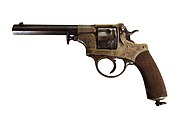| Revolver M1882 | |
|---|---|
 | |
| Type | Service Revolver |
| Place of origin | Switzerland |
| Service history | |
| In service | 1882-1949 |
| Used by | Swiss Army |
| Production history | |
| Designer | Rudolph Schmidt |
| Manufacturer | Waffenfabrik Bern |
| Produced | 1882-1929 |
| Variants | Model 1929 |
| Specifications | |
| Mass | 0.8 kg |
| Length | 235 mm |
| Barrel length | 114 mm |
| Cartridge | 7.5mm 1882 Ordnance |
| Caliber | 7.5 mm |
| Action | Double Action Revolver |
| Muzzle velocity | 690 ft/s (210 m/s) |
| Effective firing range | 40 m |
| Feed system | Six round cylinder |
| Sights | Bead front sight, U-notch rear sight |
The Revolver M1882, also referred to by the name Model 1929, was a revolver produced in Switzerland by the Waffenfabrik Bern and which was used as an ordnance arm by the Swiss Army.


